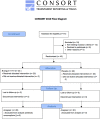Bifidobacterium longum 1714™ Strain Modulates Brain Activity of Healthy Volunteers During Social Stress
- PMID: 30998517
- PMCID: PMC6615936
- DOI: 10.14309/ajg.0000000000000203
Bifidobacterium longum 1714™ Strain Modulates Brain Activity of Healthy Volunteers During Social Stress
Abstract
Objectives: Accumulating evidence indicates that the gut microbiota communicates with the central nervous system, possibly through neural, endocrine, and immune pathways, and influences brain function. B. longum 1714™ has previously been shown to attenuate cortisol output and stress responses in healthy subjects exposed to an acute stressor. However, the ability of B. longum 1714™ to modulate brain function in humans is unclear.
Methods: In a randomized, double-blinded, placebo-controlled trial, the effects of B. longum 1714™ on neural responses to social stress, induced by the "Cyberball game," a standardized social stress paradigm, were studied. Forty healthy volunteers received either B. longum 1714™ or placebo for 4 weeks at a dose of 1 × 10 cfu/d. Brain activity was measured using magnetoencephalography and health status using the 36-item short-form health survey.
Results: B. longum 1714™ altered resting-state neural oscillations, with an increase in theta band power in the frontal and cingulate cortex (P < 0.05) and a decrease in beta-3 band in the hippocampus, fusiform, and temporal cortex (P < 0.05), both of which were associated with subjective vitality changes. All groups showed increased social stress after a 4-week intervention without an effect at behavioral level due to small sample numbers. However, only B. longum 1714™ altered neural oscillation after social stress, with increased theta and alpha band power in the frontal and cingulate cortex (P < 0.05) and supramarginal gyrus (P < 0.05).
Discussion: B. longum 1714™ modulated resting neural activity that correlated with enhanced vitality and reduced mental fatigue. Furthermore, B. longum 1714™ modulated neural responses during social stress, which may be involved in the activation of brain coping centers to counter-regulate negative emotions.
Figures








Comment in
-
Psychobiotics: Shaping the Mind With Gut Bacteria.Am J Gastroenterol. 2019 Jul;114(7):1034-1035. doi: 10.14309/ajg.0000000000000281. Am J Gastroenterol. 2019. PMID: 31268916
-
Bifidobacterium longum 1714 Does Not Modulate Reactivity to Social Stress.Am J Gastroenterol. 2019 Nov;114(11):1820. doi: 10.14309/ajg.0000000000000377. Am J Gastroenterol. 2019. PMID: 31425155 No abstract available.
References
-
- Cryan JF, Dinan TG. Mind-altering microorganisms: The impact of the gut microbiota on brain and behaviour. Nat Rev Neurosci 2012;13(10):701–12. - PubMed
-
- Kelly JR, Allen AP, Temko A, et al. Lost in translation? The potential psychobiotic Lactobacillus rhamnosus (JB-1) fails to modulate stress or cognitive performance in healthy male subjects. Brain Behav Immun 2017;61:50–9. - PubMed
-
- Savignac HM, Kiely B, Dinan TG, et al. Bifidobacteria exert strain-specific effects on stress-related behavior and physiology in BALB/c mice. Neurogastroenterol Motil 2014;26(11):1615–27. - PubMed
-
- Savignac HM, Tramullas M, Kiely B, et al. Bifidobacteria modulate cognitive processes in an anxious mouse strain. Behav Brain Res 2015;287:59–72. - PubMed
Publication types
MeSH terms
LinkOut - more resources
Full Text Sources
Medical

